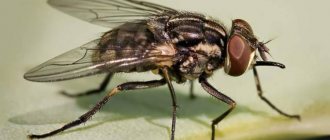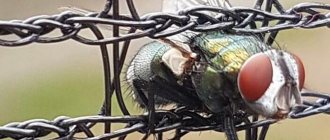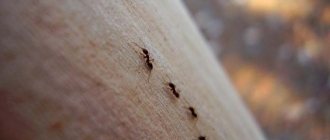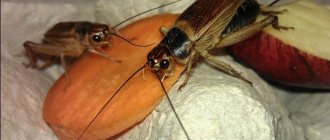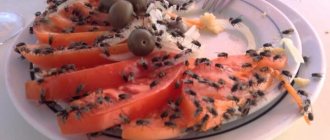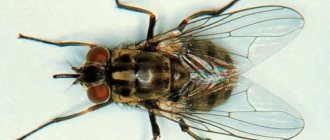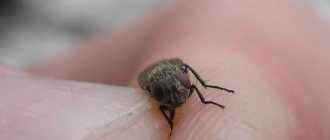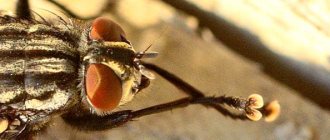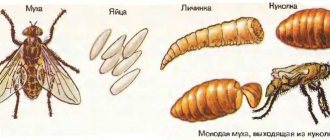22.04.2020
In the summer, flies are pretty annoying for everyone. We are desperately looking for any way to get rid of them. But in the fall the situation changes dramatically - this is due to the fact that they enter diapause or hibernation. The appearance of an insect in a house in the middle of winter is an unexpected and unpleasant occurrence. For this reason, various signs and superstitions are associated with it.
- Where do flies go in winter?
- Why do flies appear in the house in winter?
- Signs associated with flies
- How to prevent flies from entering your home
Where do flies go in winter?
In Russia, the most common housefly is the small housefly or Drosophila. They go through several stages of development. The insect remains in the egg stage for 8 to 50 hours, then a larva or maggot hatches from the egg. The larval stage, which lasts from 3 to 25 days, undergoes three molts, after which the larva pupates. The pupal stage lasts about 4-6 days. The adult stage is the longest and lasts about a month. The duration of development and life depends greatly on conditions. Under favorable conditions (high temperature, humidity, dirt, accumulation of garbage, unwashed dishes and uncleaned food), the reproduction rate and life expectancy increase. One female can lay over 100 eggs a day!
Fly larva
Several generations are replaced during the season. Most of them live their lives in summer or early autumn, but there are individuals that are born in late autumn. Then the question arises: why do flies disappear in winter? Do they all really die when the cold weather arrives?
When the first frosts arrive, synanthropes activate a protective mechanism that helps them survive at low temperatures - the insects enter diapause. All processes in the body slow down. They do not require food during this period. Moreover, both adult individuals and larvae and pupae remain for the winter. Before leaving for the winter, flies become aggressive and pestering.
It is noteworthy that only fertilized females “fall asleep” in winter; males die with the onset of the first cold weather!
Even in the fall, individuals begin to look for a suitable shelter. Typically, this is close to a warm human habitat. They hide in door or window cracks, cracks in the floor and walls, in doorposts and other secluded places. On farms, they live near barns where livestock are kept. In addition, there is manure on farms, where conditions are favorable for overwintering larvae and pupae.
Flies in the house
With the arrival of spring and rising air temperatures, fruit flies “come to life”, crawl out of their secluded shelters and return to their normal lifestyle.
Why do flies appear in the house in winter?
The appearance of fruit flies in the house is always unpleasant. They ruin our lives with their importunity. In addition, the smells of spoiled and rotten food, leftover food, crumbs and drops of drinks on tables attract them. Food thrown in the trash is a real treat for them. However, under such unsanitary conditions, a huge amount of pathogenic bacteria accumulates on their paws and bodies, thanks to which they carry dangerous infectious diseases, such as dysentery, typhoid, tuberculosis and others. On the body, the bacteria remain tenacious for several days, and in the body of an individual they can persist for several weeks, during which the bacteria spread throughout the apartment. Therefore, when they see these buzzing insects, many try to get rid of them as quickly as possible.
Fly
Drosophila are extremely agile and fast creatures. They can enter the house in several ways:
- with products. From the market, along with vegetables and fruits, you can bring larvae and eggs into the house. In favorable conditions in the house, they actively reproduce, filling the entire house.
- from the street. Even mosquito nets do not always save you from the ubiquitous flies. These insects are very nimble and sneaky. They can sneak in at the moment when a person opens the door, entering the house. Sometimes they enter an apartment through cracks in windows, holes in mosquito nets, cracks and crevices in the floor or walls.
- from ventilation. If there are no grilles with mesh on the ventilation openings, then the likelihood of flies and other insects getting into the apartment increases.
- be born already in the apartment. Before wintering, fruit flies try to protect their offspring by laying eggs in warm places, for example, in cracks in walls or floors, in slopes and other secluded places. You may not even suspect that there is an entire “kindergarten” right under your nose. But with the arrival of spring and rising air temperatures, the offspring actively develop and grow, turning into larvae, and then into adults.
Fly on food
As we already know, when it gets cold, flies hibernate, so its appearance indoors in winter is puzzling. Where could she have appeared in the apartment in winter? Don’t be scared, most likely the individual hid in your house for the winter, perhaps in the cracks of wooden windows, or in the boards in the floor, or in the garbage chute. When favorable conditions arose, she simply came out of hibernation. Most likely, the house is too hot due to heating; perhaps the place where the individual spends the winter has been heated by the warm sun. Flies can also hide in the wood you use to light the fireplace. In any case, the main reason for the appearance of fruit flies in winter is the atypically high temperature in the place where they hibernate for the winter. If an insect has come out of hibernation, it is very easy to catch it even with your hands. Simply eliminating a single individual will be enough. In winter they will not fill the house.
Where do midges come from in the kitchen?
Like other insects that live in a person’s home, Drosophila flies make their way to you with the sole purpose of profiting from something tasty. And having assessed the comfortable conditions, the midges are in no hurry to leave the territory, beginning to multiply at an alarming rate
But what exactly caught their attention in your kitchen?
Let's do a test survey: for each “yes” answer, give yourself one point.
- Do you have a habit of peeling vegetables in the sink?
- Don't you throw trash out of the kitchen until the bin is full?
- Can a plate with strawberry tails sit on the table for a couple of hours after you've eaten it?
- Do you throw garbage directly into the bin without using garbage bags?
- After eating cherries or watermelons, do you throw the seeds and skins into the trash?
- Having bought fresh fruit, you don’t put it in the refrigerator: will you still eat it in a day or two?
- Are you a summer resident and you have bowls of raspberries and currants waiting to be sorted at home?
- Do you keep a strategic supply of onions, carrots, potatoes and beets under the sink?
Well, how many points did you score? Two, three or even four? I wouldn’t like to disappoint you, but even one point is enough for a whole cloud of midges to appear in your kitchen!
You probably already understand what flies want: of course, tasty food. For the most part, they are interested in fruits and berries, but any rotting plant debris in the trash can or drain will do. Now it is clear why fruit flies appear mainly in the warm season, when we eat the most fruits and berries. Fruit flies are not interested in cereals, seasonings and animal food, so leave the cat's bowl alone. What you will have to deal with is garbage and places to store vegetables.
Signs associated with flies
Flies have been annoying people for many centuries. In turn, man not only looked for ways to get rid of them, but also carefully observed them, trying to find patterns connecting the behavior of synanthropes and the events taking place. This is how signs and superstitions appeared.
Many centuries ago, it was difficult for simple poor families to find food or earn money for it, so if in such a family an insect got into a person’s food, throwing it away was wasteful. To console himself, the man came up with a sign: if you find a fly in your food, you will receive a gift. This is far from the only superstition associated with these annoying insects.
A sadder omen is that the appearance of a fly in the house in winter foretells the imminent death of a family member. Superstition says that the fruit fly that appears in winter is a harbinger of death. As they say: the dead comes to life, and the living dies. To prevent sad events, you need to quietly knock on the glass and say: “Every time has its hour, and this misfortune is not about us.” If the next day the individual disappeared, then the technique worked.
There is a belief that if synanthropes have overcome you, you need to bury one individual. It seems funny and strange, but some peoples organized an entire funeral ceremony to get rid of the fellows of the dead insect.
There are many other signs and superstitions:
- A fly in the glass you are going to drink from is a sign of success.
- Flies greatly annoy people and bite - this means rain and bad weather.
- There are a lot of flies in the house - to the wealth of the owners.
- Flies are buzzing - to a quarrel.
- Flies rise early and disturb everyone with their buzzing - for warm and sunny weather.
Whether to believe in omens or not is up to everyone to decide for themselves. But do not forget that behind every sign there is some kind of scientific explanation.
frozen fly
What is the interpretation if the pest got into tea or other drinks
In ancient times, it was unacceptable to throw away food, even if a fly or any other insect got into it. The tea in which the fly drowned did not spill out either. Experts say that this is what determines all interpretations related to food or drinks.
It was believed that tea should not be poured out if a fly got into it. Drinking such a drink will soon lead to you receiving a pleasant surprise from a friend. If the insect drowned, then expect a big win in the lottery. A white streak will begin in life.
According to the signs, it doesn’t matter what kind of drink the insect got into, a surprise cannot be avoided. A person can prepare for the best. When deciphering, you should take into account the time of year. In winter, this is a bad sign. Only in summer does a fly foretell positive changes.
A fly in a mug means surprises
A fly found in milk foreshadows the arrival of good people. We need to prepare for this meeting. If the pest is sitting in an empty glass, then luck will smile on you.
A fly in your drink is almost always a positive sign.
How to prevent flies from entering your home
There are a huge number of different chemical and folk remedies, but their use is not always justified. It is easier to prevent their appearance and spread than to get rid of them later. To avoid the appearance of flies in the house, especially in winter, it is enough to take simple measures.
- maintaining cleanliness. In order not to create favorable conditions for reproduction and living, regularly clean your apartment, remove leftover food from the table, wash dishes immediately after eating, and throw out garbage in a timely manner.
- ventilation. Fresh cool air that periodically enters the apartment is unpleasant for insects; they will quickly leave the room.
- no cracks. Installing good double-glazed windows, eliminating cracks and crevices in walls and floors, installing good mosquito nets, and installing nets on ventilation holes will help prevent synanthropes from appearing from the street.
- setting traps. Buy traps, such as sticky tape, from a hardware store and hang them around the house. They will not get rid of eggs, larvae and pupae, but will help you cope with adult individuals.
If prevention does not help, you can resort to folk or chemical remedies. When applying insecticides, be sure to read the instructions and follow them strictly. Folk methods can also help, but it is important not to miss the moment when it is clear that folk remedies are of no use, and heavy artillery is needed.
Traps
To make protection more effective, traps are used. This method is considered one of the most reliable and effective, partly because the result is extremely clear.
Jars with sugar syrup are used as traps, inside which a cone or a lid made of a plastic bag with several holes is installed. It is this principle that is used in most traps: insects get inside, driven by the sweet smell of sugar, but cannot get out.
Trap tapes are also considered a fairly effective method, although for home use it is better to use homemade rather than professional products. To create such a trap, cardboard strips are covered with thick sugar syrup and hung in places where insects accumulate. Products should be replaced as they become filled with adherent insects.
